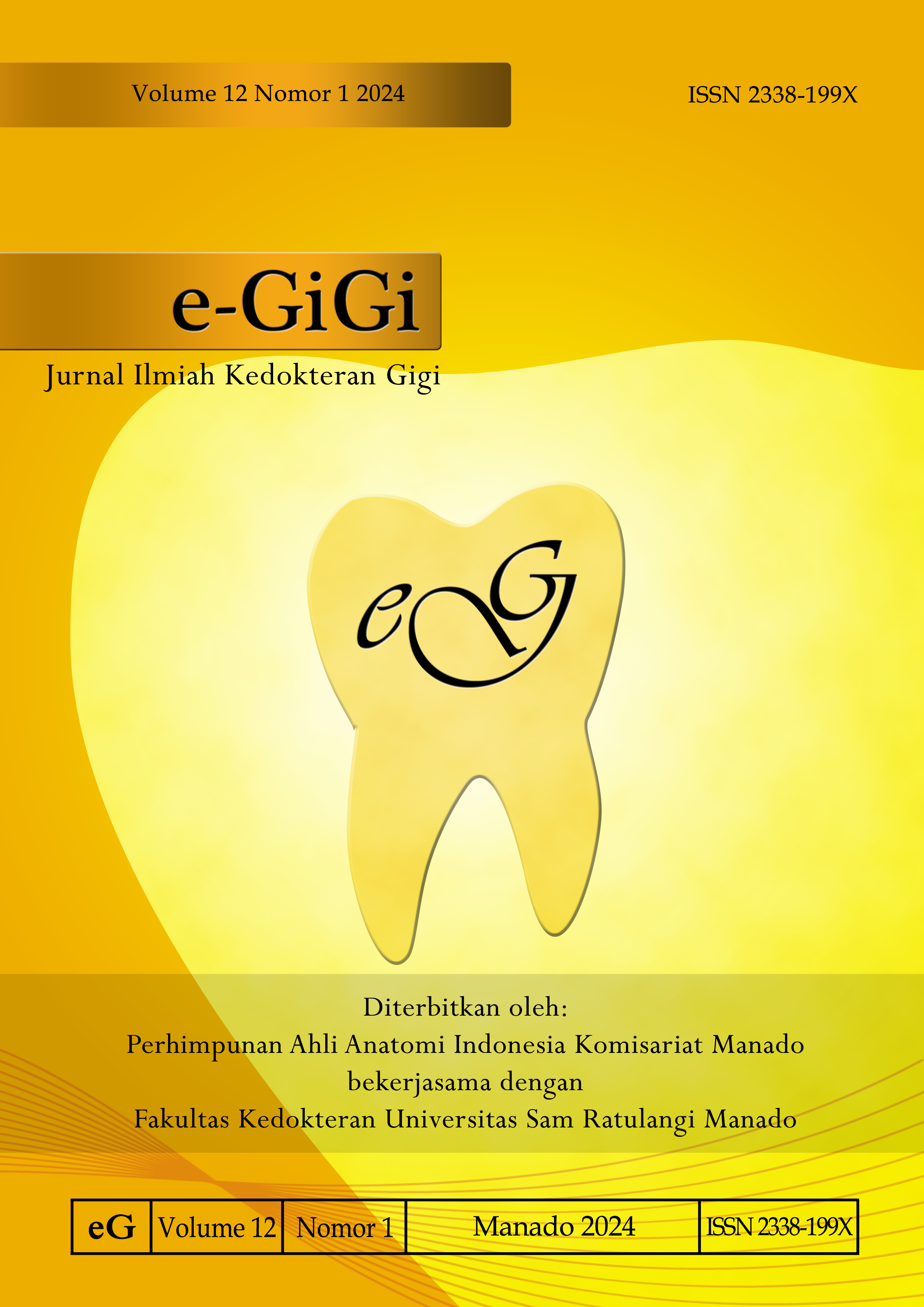Pengaruh Kebiasaan Merokok Terhadap Kejadian Dry Socket Pasca Odontektomi di RSUP Prof. Dr. R. D. Kandou Manado
DOI:
https://doi.org/10.35790/eg.v12i1.48522Abstract
Abstract: Smoking is a bad habit that is often found and has become a part of people's lives that is difficult to eliminate. One of the factors that affect the incidence of dry socket as a complication after odontectomy is smoking. This study aimed to analyze the effect of smoking habits on the incidence of dry socket after odontectomy at Prof. Dr. R. D. Kandou Hospital Manado. This was an analytical and observational study with a cohort design. Samples obtained by using total sampling technique, consisted of 32 respondents who were patients with history of smoking, whether those who had been smokers, were still smoking at that time, and did not smoke but were exposed to cigarette smoke taken using total sampling. The results showed that in terms of smoking history most respondents were active smokers. Active smokers who experienced dry socket incidence after odontectomy were 12 (37.5%) respondents. The Chi-Square test obtained a p-value of 0.000 (<0.05). In conclusion, there is a significant effect of smoking habits on the incidence of dry socket after odontectomy at Prof. Dr. R. D. Kandou Hospital Manado. This is also supported by the age, number of cigarettes consumed, length of smoking, and habit of smoking and inhaling cigarette smoke both directly and indirectly.
Keywords: smoking; dry socket; odontectomy; active smokers; passive smokers
Abstrak: Merokok merupakan kebiasaan buruk yang sering dijumpai setiap hari dan telah menjadi bagian kehidupan masyarakat yang sulit untuk dihilangkan. Salah satu faktor yang memengaruhi terjadinya dry socket sebagai komplikasi pasca odontektomi yaitu kebiasaan merokok. Penelitian ini bertujuan untuk menganalisis pengaruh kebiasaan merokok terhadap kejadian dry socket pasca odontektomi di RSUP Prof. Dr. R. D. Kandou Manado. Jenis penelitian ialah observasional analitik dengan desain kohort. Sampel penelitian berjumlah 32 responden yaitu pasien yang memiliki riwayat kebiasaan merokok, baik yang pernah jadi perokok, masih merokok saat ini, dan yang tidak merokok namun terpapar asap rokok, yang diambil menggunakan total sampling. Hasil penelitian mendapatkan bahwa dari segi riwayat merokok yang paling banyak merupakan perokok aktif. Perokok aktif yang mengalami kejadian dry socket pasca odontektomi sebanyak 12 (37,5%) responden. Hasil uji chi-square memperoleh nilai p=0,000 (<0,05). Simpulan penelitian ini ialah terdapat pengaruh bermakna kebiasaan merokok terhadap kejadian dry socket pasca odontektomi di RSUP Prof. Dr. R. D. Kandou Manado. Hal ini juga didukung oleh faktor usia, jumlah batang rokok yang dikonsumsi, lamanya merokok, dan kebiasaan menghisap serta menghirup asap rokok baik secara langsung maupun tidak langsung.
Kata kunci: merokok; dry socket; odontektomi; perokok aktif; perokok pasif
References
World Health Organization (WHO). The global adult tobacco survey. Indonesian Report 2011. 2011. p. 81–2.
Tan YL DU. The Tobacco Control Atlas ASEAN Region (4th ed). Southeast Asia Tobacco Control Alliance. 2018. p. 1–131.
Kemenkes RI. Hasil Riset Kesehatan Dasar Tahun 2018. Jakarta: Kementerian Kesehatan RI; 2018.
Kusnierek W, Brzezinska K, Nijakowski KSA, Sudacka A. Smoking as a risk factor for dry socket: a systematic review. Dent J (Basel). 2022;10(7): 121. Doi: 10.3390/dj10070121.
Sahir MY. Prevalensi dry socket pasca pencabutan gigi pada Bagian Bedah Mulut di Rumah Sakit Gigi & Mulut Drg. Halimah Dg Sikati FKG UNHAS, Makassar [Tesis]. Makassar: Universitas Hasanuddin; 2012.
Akinbami BO, Godspower T. Dry socket: incidence, clinical features, and predisposing factors. Int J Dent. 2014;2014:796102. Doi: 10.1155/2014/796102
Younis MHA, Hantash ROA. Dry socket: frequency, clinical picture, and risk factors in a Palestinian Dental Teaching Center. Open Dent J. 2011;5(1):7–12.
Komatulaini. Risiko merokok terhadap terjadinya dry socket pasca pencabutan gigi: studi kasus di Puskesmas Jemursari Surabaya [Tesis]. Surabaya: Universitas Airlangga; 2007.
Avidanti R. Efek kebiasaan merokok dalam insiden dry socket proses penyembuhan soket gigi pasca pencabutan: a scoping review [Skripsi]. Jakarta: Universitas Trisakti; 2021.
Kusuma ARP. Pengaruh merokok terhadap kesehatan gigi dan rongga mulut. Majalah Sultan Agung. 2011;49(1):124.
Halabi D, Escobar J, Munoz C, Uribe S. Logistic regression analysis of risk factors for the development of alveolar osteitis. J Oral Maxillofac Surg. 2012;70(5):1040–4.
Latief S, Parmar R, Bhandari N, Singh G, Marish P. Dry socket prevalence following third molar. Int J Res Health Allied Sci. 2021;7(3):23-6.
Jain A. Principles and techniques of exodontia. In: Bonanthaya K, Panneerselvam E, Manuel S, Kumar VV, Rai A, editors. Oral and Maxillofacial Surgery for the Clinician. Springer: 2021. p. 259–97.
Lubis W. Prevalensi dry socket pada rahang atas dan rahang bawah di Departemen Bedah Mulut RSGMP FKG USU pada tahun 2014 dan 2015 [Skripsi]. Medan: Universitas Sumatera Utara; 2016.
Dwipayanti A, Adriatmoko W, Rochim A. Komplikasi post odontektomi gigi molar ketiga rahang bawah impaksi. J PDGI. 2009;58(2):20–4.
Rahayu S. Odontektomi, tatalaksana gigi bungsu impaksi. E-Journal WIDYA Kesehatan dan Lingkungan. 2014;1(2):81–9.
Nusair YM, Abu Younis MH. Prevalence, clinical picture, and risk factors of dry socket in a Jordanian Dental Teaching Center. J Contemp Dent Pract. 2007;8(3):53–63.
Suri N, Dutta A, Siddiqui N, Kaur K, Jangra D. A literature review on dry socket. IP International Journal of Maxillofacial Imaging. 2021;6(4):97-100. Doi:10.18231/j.ijmi.2020.024.
Downloads
Published
How to Cite
Issue
Section
License
Copyright (c) 2023 Clarinda F. S. Magdalena, Victor T. Pamolango, Damajanty H. C. Pangemanan

This work is licensed under a Creative Commons Attribution-NonCommercial 4.0 International License.
COPYRIGHT
Authors who publish with this journal agree to the following terms:
Authors hold their copyright and grant this journal the privilege of first publication, with the work simultaneously licensed under a Creative Commons Attribution License that permits others to impart the work with an acknowledgment of the work's origin and initial publication by this journal.
Authors can enter into separate or additional contractual arrangements for the non-exclusive distribution of the journal's published version of the work (for example, post it to an institutional repository or publish it in a book), with an acknowledgment of its underlying publication in this journal.
Authors are permitted and encouraged to post their work online (for example, in institutional repositories or on their website) as it can lead to productive exchanges, as well as earlier and greater citation of the published work (See The Effect of Open Access).






